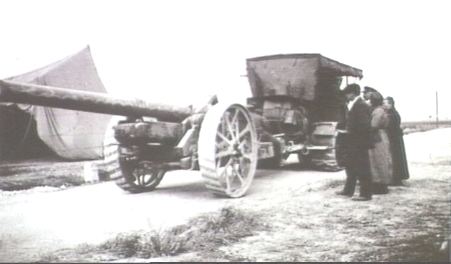Type Heavy field gun Manufacturer Vickers | In service 1916 - 1940 | |
 | ||
Place of origin United Kingdom of Great Britain and Ireland Used by United Kingdom of Great Britain and Ireland
United States
Brazil
Union of South Africa Wars World War I, World War II | ||
The British BL 6 inch Gun Mk XIX was introduced in 1916 as a lighter and longer-range field gun replacement for the obsolescent BL 6 inch Gun Mk VII.
Contents
History, description
The gun was designed and built by Vickers specifically as a field gun, unlike its predecessors which originated as naval guns. Its length was reduced from the 45 calibres of its naval gun predecessors, to 35 calibres, to reduce weight and improve mobility. It utilized the modern carriage and recoil mechanism of the BL 8 inch Howitzer Mk 6.
The gun barrel was of wire-wound construction: "The gun body is of steel and consists of tubes, a series of layers of steel wire, jacket, breech bush and breech ring".
"The breech mechanism is operated by means of a lever on the right side of the breech. On pulling the lever to the rear the breech screw is automatically unlocked and swung into the loading position. After loading, one thrust of the lever inserts the breech screw and turns it into the locked position. The breech mechanism is similar to that used on the 8 inch howitzers both in design and operation".
British service
310 were built during World War I and the gun served in all theatres, with 108 being in service on the Western front at the end of World War I, but it did not completely replace the Mk VII gun until the end of the war.
3 batteries served with the BEF in France early in World War II, and others were deployed in the home defence of Britain. The gun was superseded by the 155-mm Gun M1, and the carriages used for BL 7.2-inch howitzer
US Service
"Handbook of artillery" of May 1920 stated that :
"The original British ammunition so closely resembled the American that it was decided to use the [US] regular Mark II high-explosive shell... the propellant charge will consist of a base section and increment section having a total weight of approximately 25 pounds".
Brazil service
Brazil purchased these guns from USA in 1940 for coastal defense.
South African service
Prior to the outbreak of World War II there were plans to use these guns in the fortification of Durban, Cape Town and Saldanha Bay.
For a short period, two guns were deployed for the protection of Port Elizabeth harbour at the outbreak of World War II.
